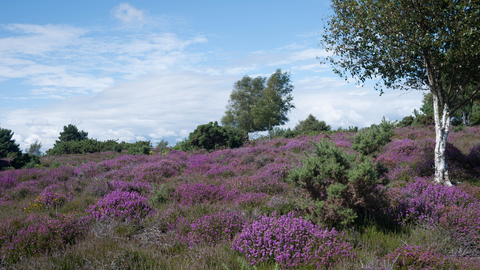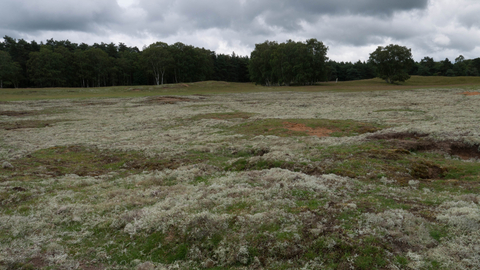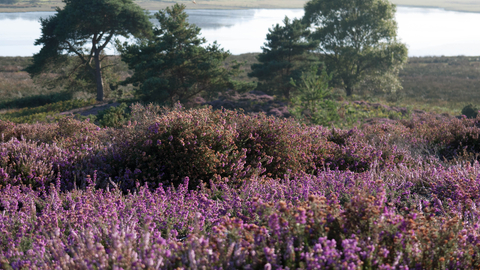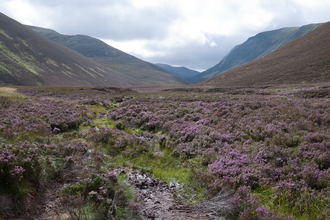


Lowland heath
Beth yw o?
Lowland heath is found from sea-level up to about 300m and is characterised by heathers, gorse and grasses. On infertile, well-drained sands and gravels in the drier and colder east of the country, heather and gorse are dominant. Such heaths generally support relatively few plant species, and a lack of competition allows lichens to flourish.
As the climate becomes increasingly damp towards the west, dwarf gorse and bell heather are more common. Then western gorse and bristle bent and purple-moor grass. Heaths support ground-nesting birds, reptiles and invertebrates.
Wet heath is found where either shallow peat or mineral soils are seasonally waterlogged and supports cross-leaved heath, heather and bog mosses. Wet heath may be more species-rich than dry heath, with lousewort and heath spotted-orchids. Particularly damp areas support the distinctive white beak-sedge and sundews. In shallow valleys in heathland, a type of lowland fen known as valley mire may be found, and is characterised by bog-mosses, rushes and purple moor-grass.
Pam fod o fel hyn?
Lowland heathland is defined by the poor fertility of its soils, which discourages other plants, and a long history of human management. Nutrients gradually accumulate allowing larger, more vigorous plants to become established at the expense of smaller, less competitive species. This results in heathland eventually developing into birch or pine woodland if left to its own devices. Traditional heathland activities such as livestock grazing and burning have played a vital role in allowing heathland to persist over the centuries.
Only plants adapted to the poor, acidic heathland soils flourish. Some resort to unusual means to gain nutrients - carnivorous sundews have glandular tentacles with sticky droplets on their leaves. These catch unwary insects and curl inwards, holding the insect while they gradually absorb the nutrients released.
Although many species are restricted to heathland in the UK, this is, in some cases, a reflection of the presence of suitable microhabitat and the climate. Many specialists require warm, sunny conditions with bare ground and nearby vegetation for basking or shelter, conditions which in warmer countries are not so restricted to heathland.
Dosbarthiad yn y DU
Lowland heathland is scattered across the UK, although largely absent from Scotland and north Wales.
Beth i edrych am
In early spring, listen out for what is arguably Britain’s most beautiful bird song, that of the woodlark. Between May and August, the distinctive churring of nightjar may be heard at dusk from mature heath. All six reptiles can be found on heathland - look on sunny mornings in spring when the air is still cool and they need to bask in the sun to warm up.
Invertebrates are at their best in June and July – heathland supports many rarities that are hard to find, but the striking green tiger beetle and the beautiful day-flying emperor moth are more common, while eye-catching clouds of silver-studded blue butterflies can be seen flickering over short open heath. On damp heathland tracks in the south-west, look out for a group of specialist plants, including the tiny gentian yellow centuary and the starry-flowered white water buttercup, three-lobed water crowfoot. From April, many heaths turn yellow as gorse blossom is at its most abundant, but heathers flower later and are at their best in August. Look for Dorset heath and Cornish heath if you are in the right area. Also in August, look out for the lovely blue marsh gentian on wet heath.
Cadwraeth
Lowland heathland requires some kind of human intervention if it is to persist. Over the last few decades, this intervention has largely been instigated by conservationists in an attempt to save the meagre 20% of lowland heathland that survived the last two centuries.
There are, however, notable exceptions, such as the New Forest, where the tradition of common grazing by farmers and smallholders continues. Extensive grazing using hardy breeds of cattle, ponies or sometimes sheep, cutting heather and gorse and some controlled burning combined with activities to create bare ground such as scraping or turf removal are all techniques used to manage the habitat.
Restoration work and reintroduction of some species has also been carried out. Despite this, not all heathland species are flourishing, and more targeted work, often around the creation of bare ground and the prevention of nutrient enrichment is needed. The level of recreational use of some heaths also presents challenges such as arson, trampling and disturbance to ground-nesting birds.

